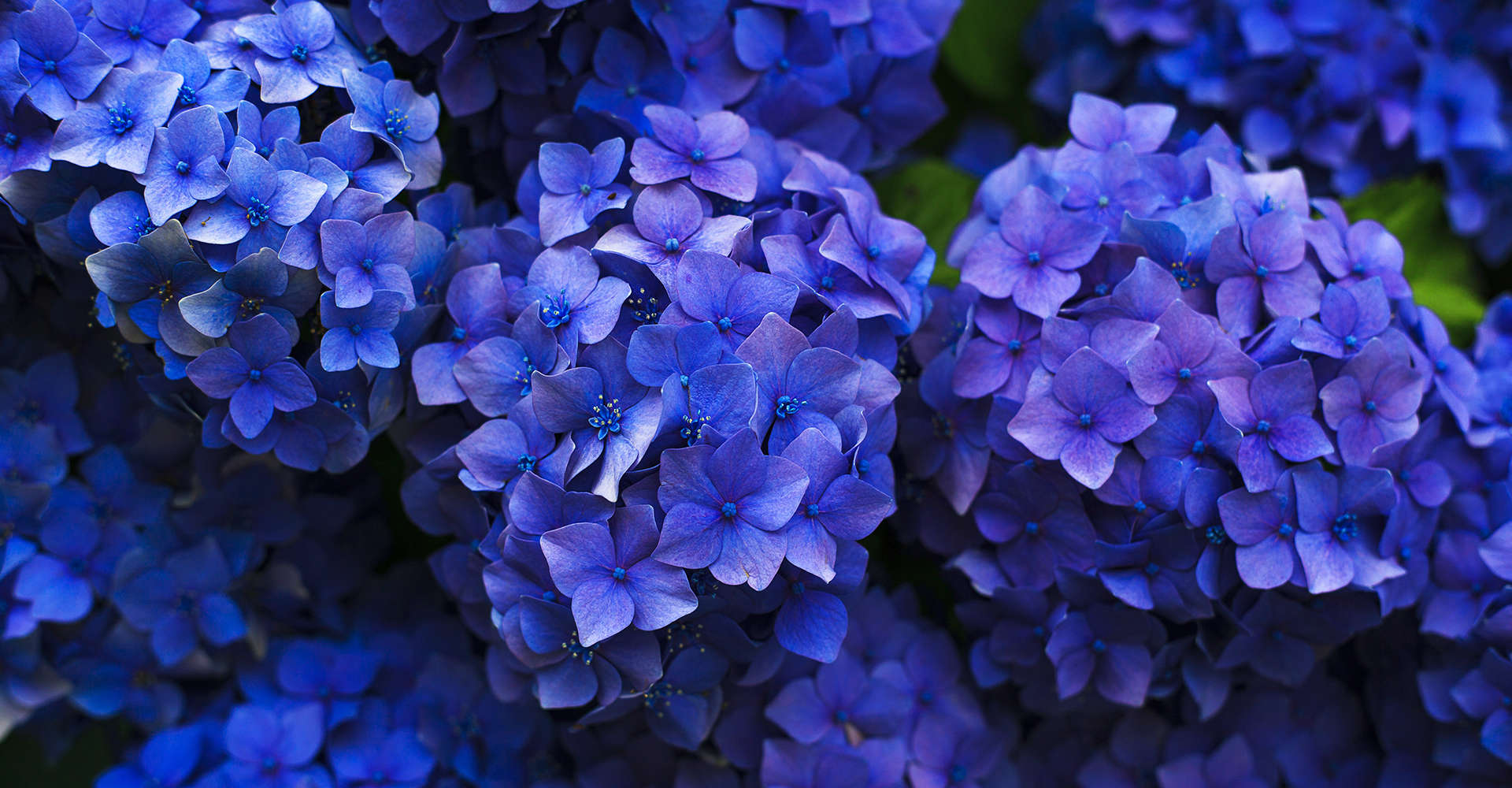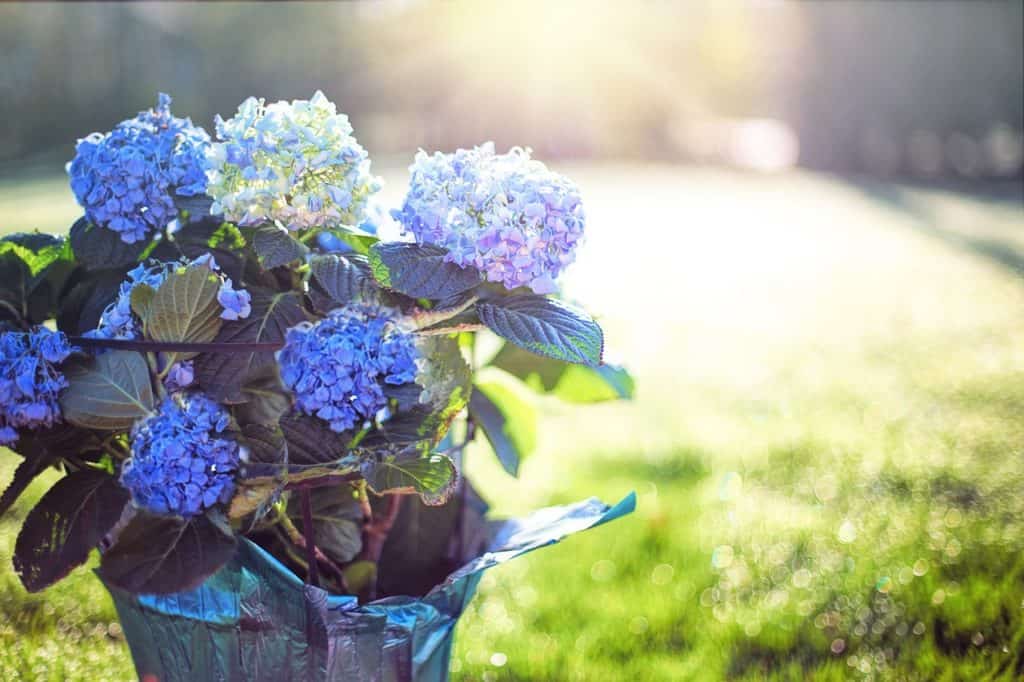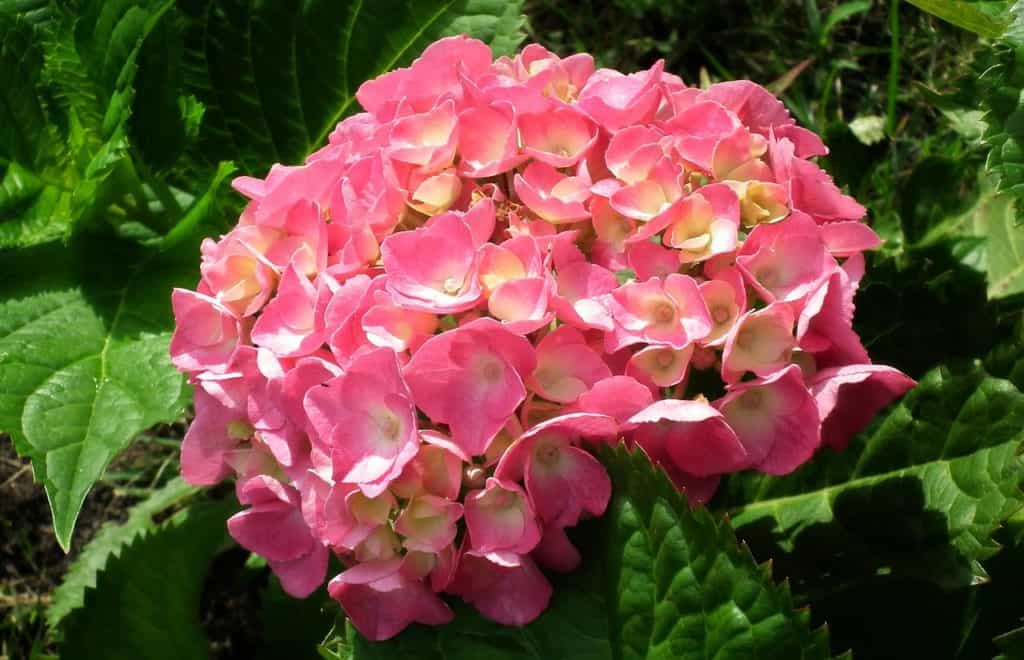
Jump to a Section
Plant Overview
| Common Name | Hydrangea |
|---|---|
| Scientific Name | Hydrangea |
| Plant Family | Hydrangeaceae |
| Origin | This shrub is native to southern and eastern Asia and the Americas |
| Height | This varies considerably. Grandiflora are the tallest and are really small trees that can reach 25 feet (7.5 metres), while Sikes Dwarf tops out at 3-4 feet (90-120 cm) |
| Light | Most hydrangeas need 3-4 hours of sunlight to flower well |
| Temperature | Depends very much on variety, H.arborescens may need winter protection if the temperature falls below 0℃ |
| Hardiness | Most are very hardy. Occasionally new shoots can be damaged by late frosts |
| Soil | Asian varieties prefer acid soil. Flower colour may vary depending on soil pH |
| Fertiliser | Fertilise your shrub with organic soil improver or a slow release shrub fertilizer in early spring |
| Propagation | From softwood or hardwood cuttings |
| Pests | Hydrangea Scale, Rose chafers |
| Difficulty | Easy |
Hydrangeas are deciduous plants known for their large heads of long-lasting blooms.
Perhaps most of us are most familiar with the hydrangea variety that has blue flowers when planted in acidic soil and pink when in alkaline soil. However, there are many other types of hydrangea, from big snowball-like white blooms to delicate lacy varieties.
These shrubs are easy to grow, hardy and resistant to most pests and diseases. The huge range of varieties means there is a hydrangea to suit every garden.
This guide will cover how to choose and care for hydrangeas in your garden.
Hydrangea Care

Hydrangeas are generally easy to grow and care for. The different varieties do need slightly different conditions, so check the individual plant for more detailed instructions on care.
Light Requirements
Most hydrangeas prefer to be located in full sun or partial shade. However, they do not like exceptionally hot, arid conditions so if your garden receives a lot of sun they will prefer to be a little protected from the worst of the heat.
Water Requirements
Hydrangeas usually need a deep watering about once a week. In very dry weather they may need even more. It is best to give them a thorough watering rather than a light sprinkling every day. Water your plants at the base rather than on the leaves to help prevent too much humidity which can encourage fungus to thrive. Water early in the day to allow any moisture on the leaves to evaporate.
The American varieties are more drought tolerant than the Asian ones.
Soil Requirements
Hydrangeas can grow in a wide range of soils including acid and alkaline types. However, the Asian varieties need acid soil in order to flower. All types prefer a rich soil that is moist but free draining. If planted in dry soil they will need more watering. If your soil is poor, then adding extra compost and organic matter can help them thrive.
Fertiliser Requirements
Fertilise your shrub in early spring to support new growth and plentiful blooms. You can use an organic soil improver or a slow release shrub fertilizer. You may like to repeat this in summer, depending on your soil conditions. However, do not fertilise after August as this can encourage new growth that will be too tender to survive harsh winter weather. There are special hydrangea fertilisers available, but these are not really necessary.
Do not be tempted to over fertilise your shrub. If your plant is looking sickly it is important to find out exactly what is wrong rather than just feeding it more. Over fertilising can cause more problems for an already stressed plant.
Hydrangeas also benefit from an application of liquid iron every two years. This will keep the leaves nice and green and healthy. This is particularly important for the Asian varieties.
If you are growing a pink or blue variety, you can keep the colour you want by adding small quantities of either sulphur or lime to the soil. Lime will result in pink blooms and sulphur will turn them blue. This will not happen overnight, so you will have to be patient.
Planting
You should plant your hydrangea in spring once all threat of frost has passed. Dig a hole twice the size of the rootball and add some soil improver or compost. Plant level with the surrounding soil and water in well.
Add a layer of mulch to help retain moisture and suppress weeds. Do not let the mulch touch the base of the plant to reduce the risk of rotting.
If you should need to move your shrub for any reason this should be done in autumn or winter when the plant is dormant. Try to make sure you get the whole rootball and replant immediately to avoid stress to the plant.
Maintenance
To keep your hydrangea looking at its best you should dead-head whenever the blooms become spent.
This will divert the plant’s energy to new growth and blooms. The correct way to deadhead your hydrangea depends on the time of year. Before August spent blooms should be cut back to a larger branch on which new buds are present. After August, there will be buds on the stems in preparation for next year’s blooms, so you should cut back only to these. Cutting back further at this time of year may result in a loss of flowers the flowing year.
In winter it is sometimes appropriate to leave the spent blossoms on the plant. This is because the new buds for next years growth are just below the old blossoms so leaving them on can provide protection for these tender buds over winter.
Container Grown Hydrangea
Hydrangeas are often given as gifts in small pots but unless re-potted these will rarely last more than a few weeks. Ideally, you need to re-pot hydrangea into a container several inches larger than the one it came in to give its roots access to plenty of moisture and nutrients. Ensure the pot has plenty of drainage holes so that your plant doesn’t sit in water. Leave a few inches between the potting compost and the rim of the pot.
This will enable you to water it well without water and soil spilling out of the pot. Hydrangeas like plenty of sun, however, they do not like to dry out. For this reason, it’s best to put your container-grown plant in a place that gets morning sun, but a little shade in the hottest part of the day.
Your container grown hydrangea may need some protection in winter. You can place it in a cold greenhouse or protect it with fleece. Remember not to let it dry out over winter. It will not need much water, but it will require some.
Repotting
If your hydrangea is not a dwarf or compact variety it may need repotting again in time, or alternatively, you can prune it to the size you want. Make sure you prune it at the right time of year for the variety or you may lose the next years blooms.
Pruning Advice
The different varieties of Hydrangea have different pruning needs.
The most common types, the mopheads and lacecaps of the H. macrophylla variety, usually need pruning after blooming in late summer.
Paniculata should be pruned in late water or early spring, though the spent flower heads can be cut as they die back.
Arborescens can be cut back to flower buds in early spring.
The oakleaf varieties are best pruned in early spring.
Hydrangea Propagation
Hydrangea can be propagated by seed, softwood cuttings and hardwood cuttings. The most effective method is propagation by softwood or hardwood cuttings.
Propagating Hydrangea by Softwood Cuttings
Softwood cuttings are taken in spring and early summer. Cuttings are taken from the soft flexible tips.
You should take your cutting early in the day when the plant is full of water. Choose a healthy, non-flowering tip and remove a stem of 10 centimetres (4 inches) in length with a clean, sharp knife.
Prepare a 4-inch pot filled to half an inch from the top for each cutting. Make a hole in the compost with a dibber or pencil.
Trim the base of the stem to just below a leaf joint. Remove the leaves from the lower third of the stem and pinch out the tip. Dip the base of the cutting in hormone rooting powder and push the stem into the hole up to the first leaves. Mist the pot well and cover with a plastic bag or in a propagator and position somewhere bright but out of direct sunlight.
Check your plant weekly and remove the bag to allow for air circulation for at least ten minutes. Remove any dead or dying matter. Water and replace the bag. Cuttings should root in around 6-10 weeks.
Propagating Hydrangea by Hardwood Cuttings
Hardwood cuttings are taken in autumn, after leaf fall, or early spring, before bud-burst.
Select vigorous shoots from the current year’s growth and cut off with a sharp knife. Remove the soft tip growth and cut each stem into sections of 15-30 cm (6 -12 inches) with the top cut being at an angle and just above a bud.
Cut straight across at the base below a bud and dip this end in rooting hormone powder. Insert the straight end into well-prepared ground outdoors or pots. Keep the cuttings moist and leave until the following autumn before transplanting.
Common Hydrangea Problems
Hydrangeas are usually fairly resistant to pests and diseases. However occasionally one of the following may give your plant some trouble.
Pests
There are a couple of different pests that can cause problems for hydrangeas.
Hydrangea Scale
If your plant is infected with hydrangea scale, you may see the oval white eggs attached to the stems of the plant. These little sap-sucking insects can affect the growth of your plant. A mild infestation can be solved by scraping off the eggs. Severe infestations may require a pesticide which should be applied in mid-July. Applications may need to be repeated to break the life cycle of these pests.
Aphids
Aphids such as blackfly and greenfly can cause distorted leaves making it harder for your plant to photosynthesise. They can be removed with a strong jet of water or by spraying with a soap solution.
Rose Chafers
Rose chafers are a beetle that can sometimes eat the leaves and flowers of hydrangeas. They are often best removed by hand, though a pesticide may be required if the infestation is widespread.
Diseases
Hydrangeas are usually resistant to most diseases. Good hygiene can help to keep your plant in excellent condition. In particular, ensure sure all pruning tools are sterilised before each use. These diseases can cause problems for hydrangeas.
Cercospora Leaf Spot
This fungal disease appears as purple to brown spots on the leaves of your plant. It is rarely fatal, but it can weaken the plant.
To prevent the spread of the disease, clear up all debris from around the plant and dispose of it in the rubbish or by burning to prevent re-infection.
Reducing humidity and improving air circulation can make your plant less attractive to fungal infections. Make sure you water your plant at the base, rather than the leaves. Also, thin out crowded and crossed over stems to allow better air circulation. You may want to cut back up to a third of the branches within the crown. You should also cut back any other plants that are encroaching on your hydrangeas space and remove any weeds from the surrounding area.
In bad cases, there are fungal sprays that you can use to treat leaf spot fungus.
Powdery Mildew
If your plant is suffering from powdery mildew you will see powdery white patches on the leaves. You should remove all infected material and put it in the rubbish rather than the compost to prevent reinfection. Increasing air circulation can help to solve this problem. Good watering techniques will also help prevent this disease. Water at the base of the plant and do so early in the morning to allow any moisture on the foliage to evaporate quickly. You can also use a fungicidal spray to clear up this fungus.
Rust
Rust shows as orange or reddish pustules on the leaves, which is what gives the disease its name. However, the pustules can sometimes be brown, black or white.
If only a few leaves are affected you should pick these off, however, if lots of leaves are affected it may do more harm than good to remove them. At the end of the season, all diseased material should be removed and destroyed. Often, no treatment is needed as this disease develops late in summer and will not have a significant effect on the health of your plant.
However, a fungicide may be used if required.
Hydrangea Varieties

Hydrangeas come in many varieties. The most well-known are the mop-head varieties and the Lacecaps. Some varieties originate from Asia and others from the Americas and the two types need to be treated differently in order to thrive.
The varieties can be separated 4 main groups: big-leaf, smooth-leaf, panicle and oakleaf varieties. These four groups are all relatively easy to care for and provide a wonderful summer display. You’ll find a break down of these different varieties below.
For climbing hydrangeas, take a look at our Climbing Hydrangea Guide.
Big-leaf Hydrangeas (Hydrangea Macrophylla)
Hydrangea macrophylla or big-leaf hydrangeas are the colourful varieties that we know so well.
These are the types that have pink or blue blooms depending on the pH level of the soil. There are two types, Hortensia, which have the big rounded balls of flowers, and Lacecaps which are more delicate.
Good varieties of Hortensia include Nikko Blue and Carmen.
This variety is of Asian origin and prefers moist conditions and acidic soil. They may fail to flower if planted in limey or chalky soils.
Smooth-Leaf Hydrangeas (Hydrangea Aborescens)
Hydrangea arborescens or smooth-leaf hydrangeas have extremely large, round flower heads. The heads can reach 10-12 inches across. They are not quite as hardy as other varieties and so will need a sheltered spot and possibly some protection from harsh winters.
Anabelle is one of the most popular of this variety. This is an America species that is drought tolerant and will cope better with alkaline soil than the Asian varieties. These varieties flower on new wood and so can be pruned in late spring back to the shooting bud.
Panicle Hydrangeas (Hydrangea Paniculata)
Hydrangea Paniculata is the hardiest type and also prefers more sun than the big-leaf varieties. They have cream-coloured flowers and the blooms are cone (panicle) shaped.
Grandiflora is a good example of this variety. It has huge white blooms that slowly turn pink as they age. It is also one of the largest, reaching the height of a small tree over time and in the right conditions.
Oakleaf Hydrangeas (Hydrangea Quercifolia)
Hydrangea quercifolia has leaves shaped like oak leaves. They also have brilliant autumn foliage. The flowers are white, though some age to a pinkish hue. The blooms are cone-shaped and can be single or double. This is an American variety and can withstand drought better than the Asian types.
One example of an oakleaf hydrangea is Snowflake, which features double blooms. Sikes Dwarf is a compact variety suitable for a smaller garden or container.
FAQs
If the purple is in patches it may be that your plant is suffering from Cercospora leaf spot. However, if the leaves are turning purple all over rather than in patches it could indicate a phosphorous deficiency.
Many hydrangeas like very acidic soil. However, if the soil becomes too acidic, chemical compounds in the soil bind the phosphorous which makes it impossible for the plant to use. Check the pH level of your soil and if necessary, add some phosphorous fertilizer to the plant’s root zone.
There are several possible reasons why your hydrangea is failing to flower. It may not be getting enough sun; these plants need around 3 hours of sun each day to flower well. You may have pruned it at the wrong time; most hydrangeas need pruning straight after flowering to allow new growth and new flower buds to develop for the following year. This does depend on the variety though so check the pruning advice above for more details.
Other possibilities include soil that is too alkaline, hard frosts in early spring have damaged new buds, or too much nitrogen, which has encouraged leafy growth at the expense of blooms.
This could be caused by too much sun, too little water, or both. Try giving your hydrangea a good soaking once a week to see if this helps. If your plant is exposed to strong sunlight you might need to move it or create some shade at the hottest part of the day.

Share